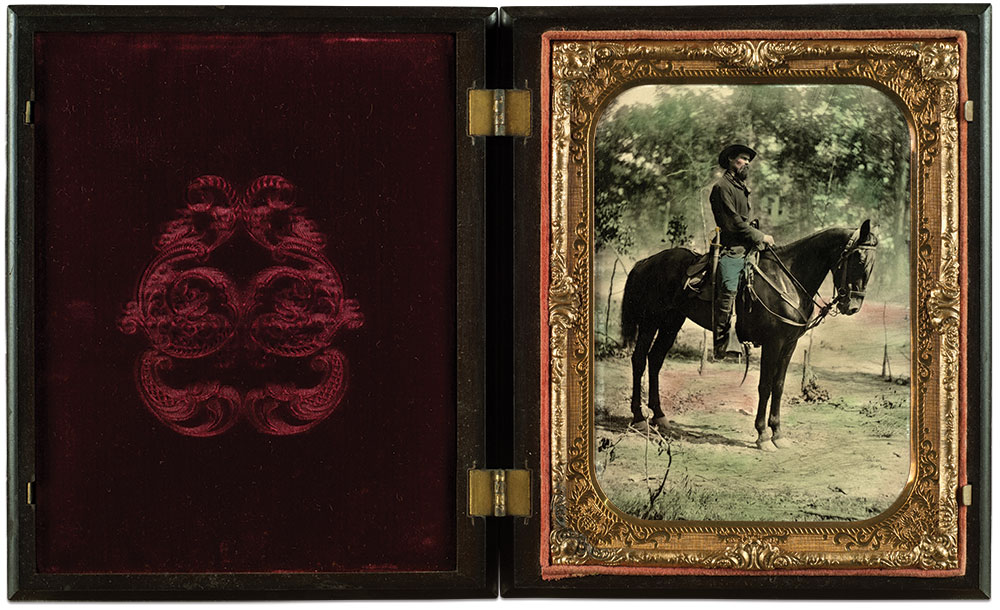
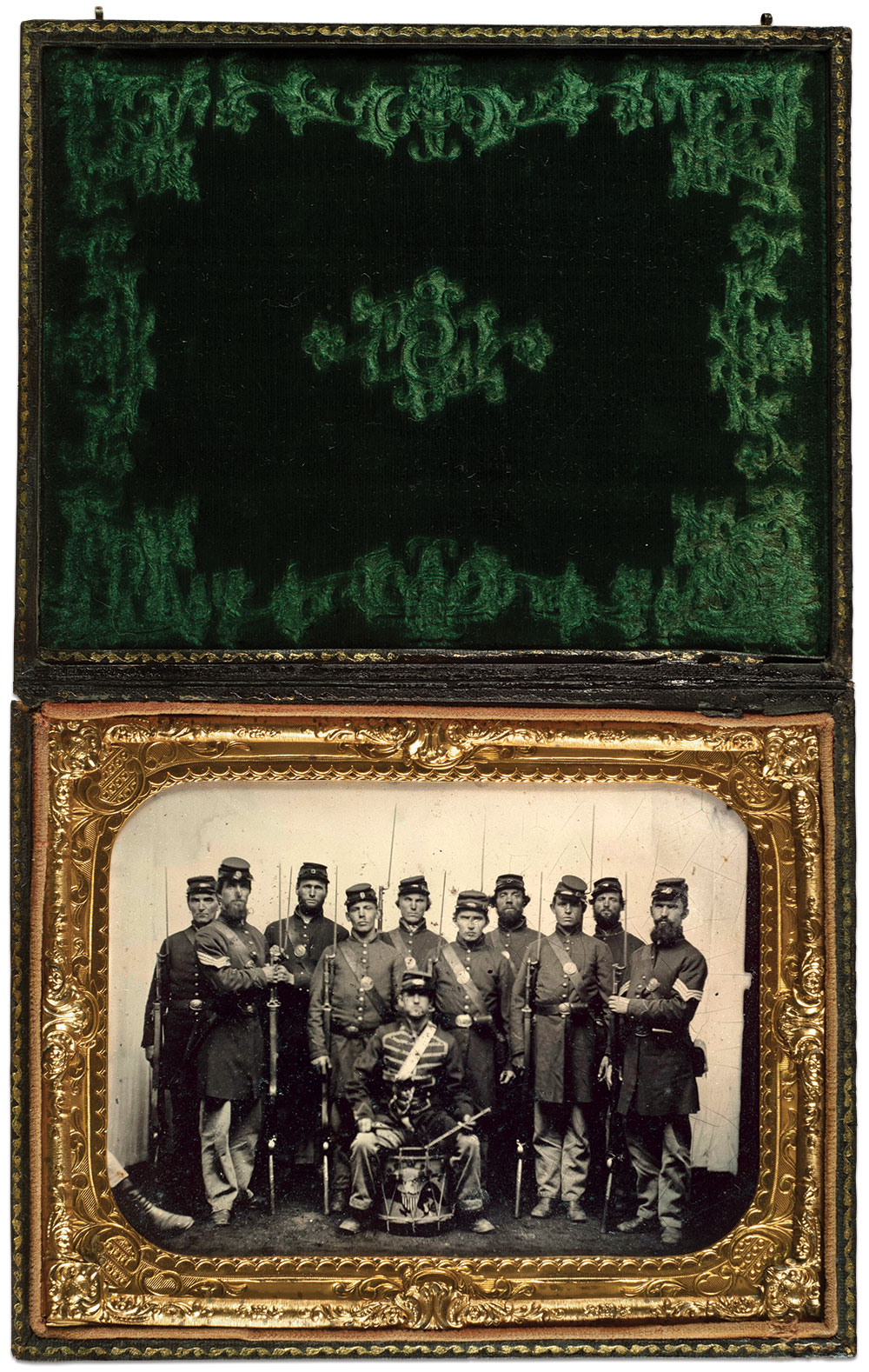
The bare ground and simple canvas backdrop are telltale signs of an enterprising photographer’s makeshift camp studio. The soldiers probably posed for this photograph in the Eastern Theater during the mid- to late-war period.
Visible along the lower left edge are the boots and trousers of another soldier, likely the photographer’s next customer.
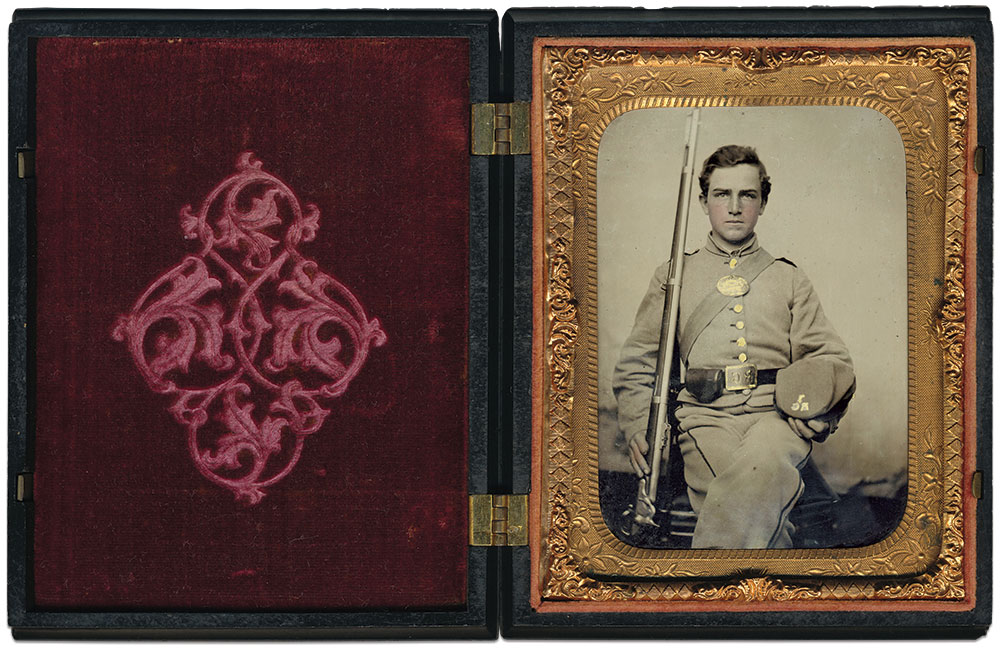
A youthful private in the 1st Virginia Richmond Grays poses with his Model 1855 rifle-musket with long-range rear sight. The federal government distributed these state-of-the-art weapons to the states under the Militia Act of 1808. He wears the undress uniform adopted by the Richmond Grays in 1859. His gray shell jacket is complete with contrasting piping at the base of the collar and epaulettes, and his trousers are appropriately trimmed. He wears a waist belt fastened by a belt plate with the letters RG and a 1st Virginia breastplate. Attached to the top of his high-crowned cap is the number 1 above the RG.
Of special interest is the absence of the young man’s index finger on the hand holding the musket. What prompted the loss of the finger is not known, though the swelling of the finger and noticeable flap of skin protruding over the stump suggests a relatively recent amputation.
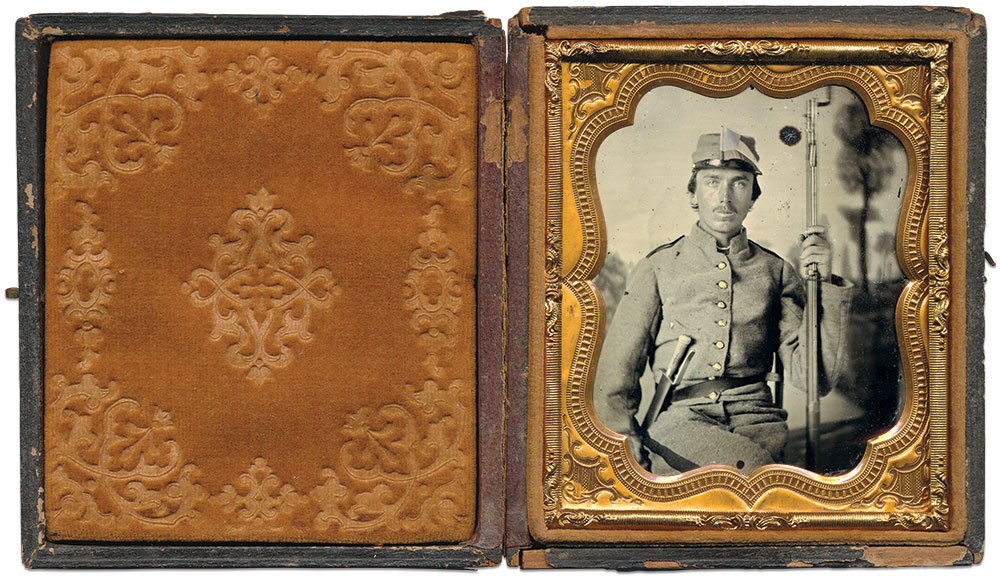
A Confederate national flag rises from the cap of this soldier, a testament to his patriotism. It also distinguishes his gray shell jacket from similar styles worn by some Northern militiamen early in the war. His jacket, with contrasting epaulettes and single button pocket, and his trousers with a wide stripe are characteristically Southern. He is armed with a distinctive side knife with an open guard and a Model 1842 musket.

A Confederate soldier holds a U.S. Model 1816 Springfield musket (Type III) that has been converted from flintlock to percussion—the Harpers Ferry 1837 marking on the weapon’s lock plate is plainly visible. In the other hand, he holds the matching bayonet. His chasseur cap with contrasting peaked band is typical of those worn in 1860 and 1861. His coarse battle shirt and Southern-issue canteen completes the picture.

An early Southern officer, who is believed to be from Mississippi, is impeccably dressed in a well-tailored and trimmed frock coat and trousers. He rests a finger across the scabbard of an ivory-handled sword that dates before the war. A silk sash with a long fringe completes the portrait.
This table and its cloth can be found in other images attributed to a Shenandoah Valley, Va., photographer who may have worked in Staunton or Rockbridge. James Miller is written on the case, which name matches several soldiers from the Valley who served in the army.
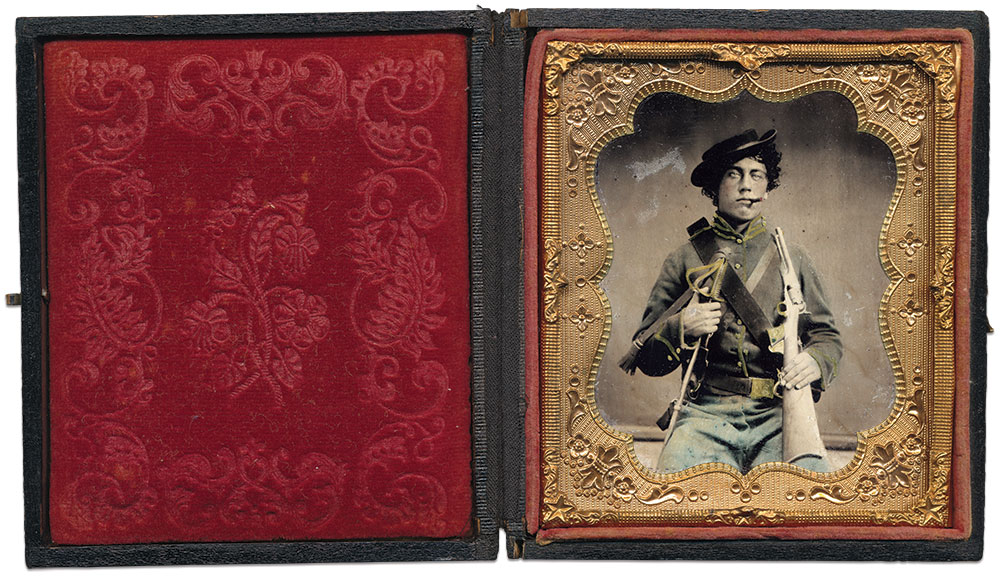
The cigar and jaunty angle of the slouch hat worn by this Union cavalryman leaves an impression that he is fearless. The Model 1860 Colt Army with shoulder stock and carbine sling was likely issued to him and is not a prop. Its presence suggests an early war-date because its medium and long-range accuracy was no match for contemporary carbines issued later in the conflict.
Note that the trooper wears a standard issue 2.5-inch wide leather carbine sling, to which is attached a carbine snap hook that is fastened to the ring of the sling swivel, set below the wrist of the stock. This rig allowed the pistol-carbine to be carried without the possibility of loss, which was especially useful while riding in combat with the sword in the right hand and the horse’s reins in the left.
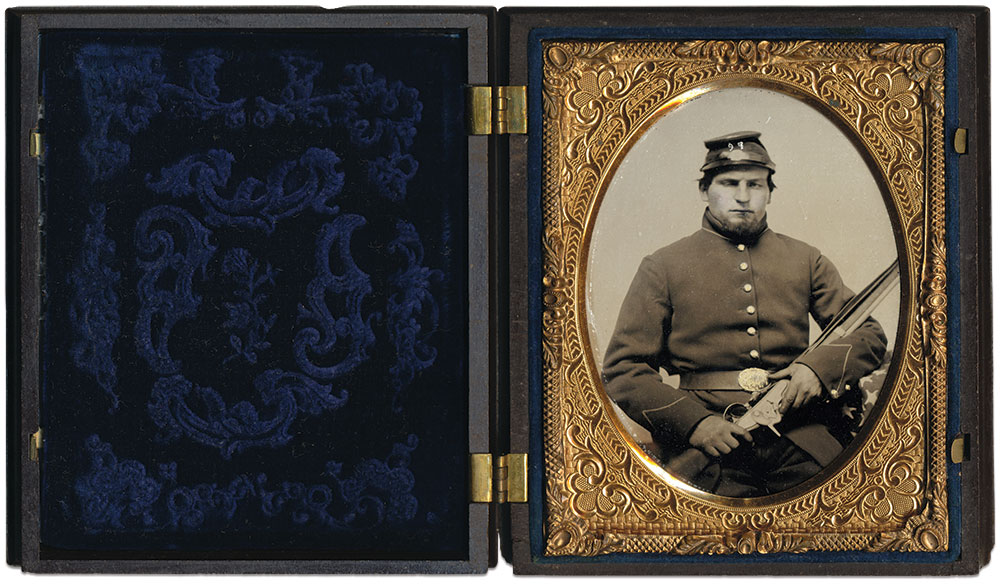
This Northern soldier with the weak or injured left eye is most likely an early volunteer, as evidenced by the 97 scratched into the surface of the ambrotype on his cap. Five states raised regiments with the number between August 1861 and September 1862: Indiana, Illinois, New York, Ohio and Pennsylvania. His uniform and weapon support this timeframe. He holds a Model 1822, also known as Model 1816, Type II, which underwent the Remington tape primer alteration. His cap appears to be a private purchase or state issue McDowell style, rather than standard federal issue. His trousers are dark blue rather than light blue, which was common in 1861, and his frock coat shows only six of the nine expected buttons.
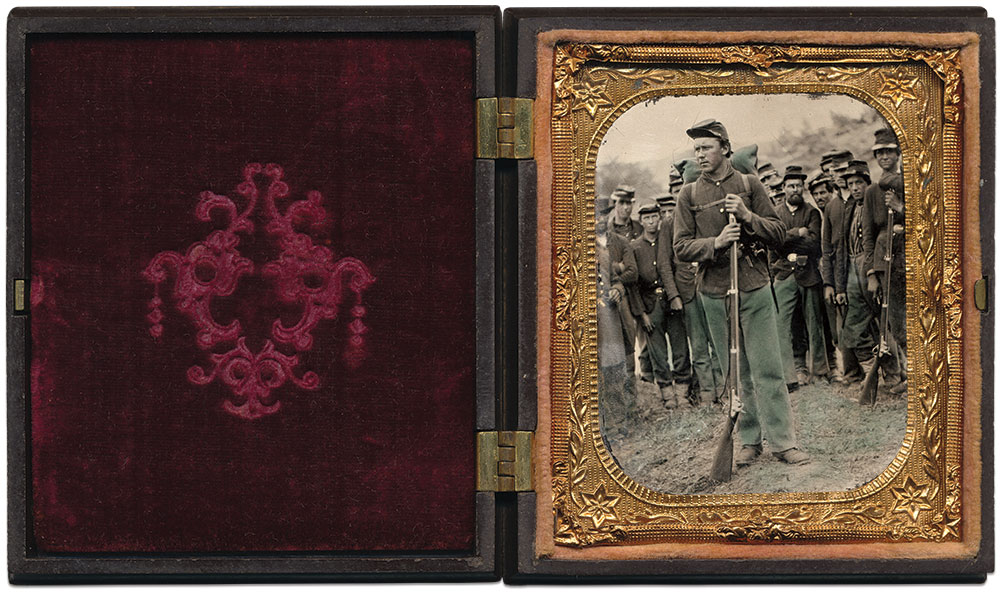
Though the particulars of the story behind this photograph are currently lost to history, the soldier surrounded by his comrades was undoubtedly the central figure. Resting his hands on the barrel of a Model 1855 rifle-musket, he sports a small pistol tucked into his belt. It appears to be a Colt Model 1849, which is more commonly seen in early war images. He also carries a knapsack that could have been state issue or private purchase, such as a Short’s patent, as indicated by the buckle on the cross strap. The soldiers around him wear standard four-button sack coats, sky blue trousers and caps common to infantrymen. Two men don private purchase caps, and three wear leggings.
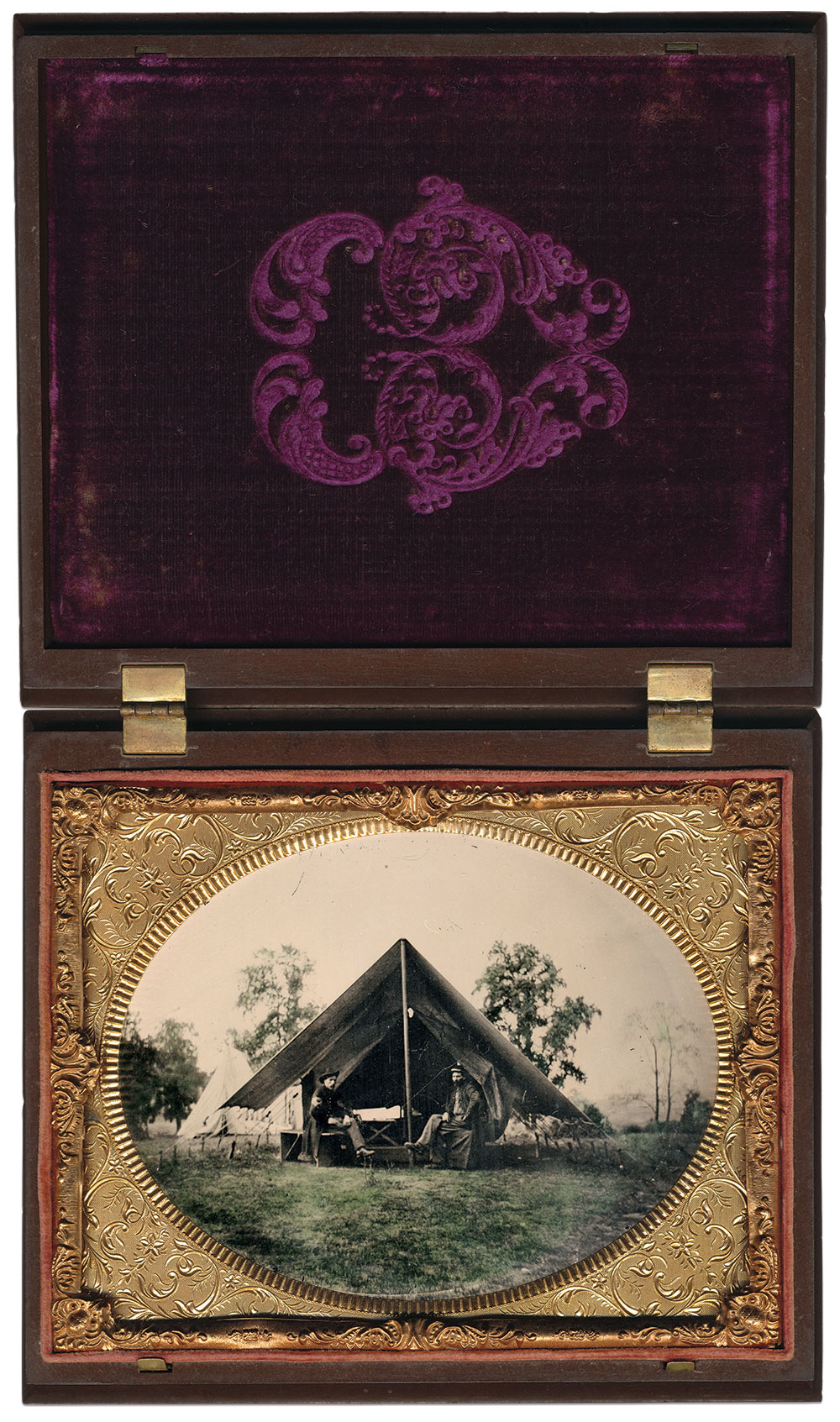
A Union sergeant major relaxes with a comrade who is likely a private, based on the absence of stripes and two-button cuffs on his coat. Both soldiers sit in front of a wall tent with a separate fly. The wooden floor beneath the tent, and the worn ground in front of it suggests that these men are in garrison rather than on campaign. An A-frame tent is visible in the background. Meticulously tinted grass and trees in full foliage suggest this portrait was made during the warmer months.

The weathered hands of this soldier who served in the U.S. Colored Troops suggest a life of manual labor. Odds are that he was a slave prior to his enlistment. Dressed in a newly issued uniform, the palpable dignity and pride in his expression is consistent with observations made by white officers who commanded African Americans beginning in late 1862 through the rest of the war.

The uniform worn by Henry G. Thompson, a private in Company K of the 13th New Hampshire Infantry, has been modified for comfort. The collar of his standard nine-button frock has been lowered, and he wears a privately purchased military vest. His cap, also standard issue, is marked with the letters NHV, which is common to soldiers from the Granite State. His unnamed canine friend covers the V.
Thompson was a member of the regiment during the Fredericksburg Campaign in 1862 and operations in southeastern Virginia in 1863. He left the regiment with a disability discharge in early 1864 and went on the serve as a commissary sergeant in the Veteran Reserve Corps. He survived the war and died in 1927 at age 85. His wife and three children survived him.
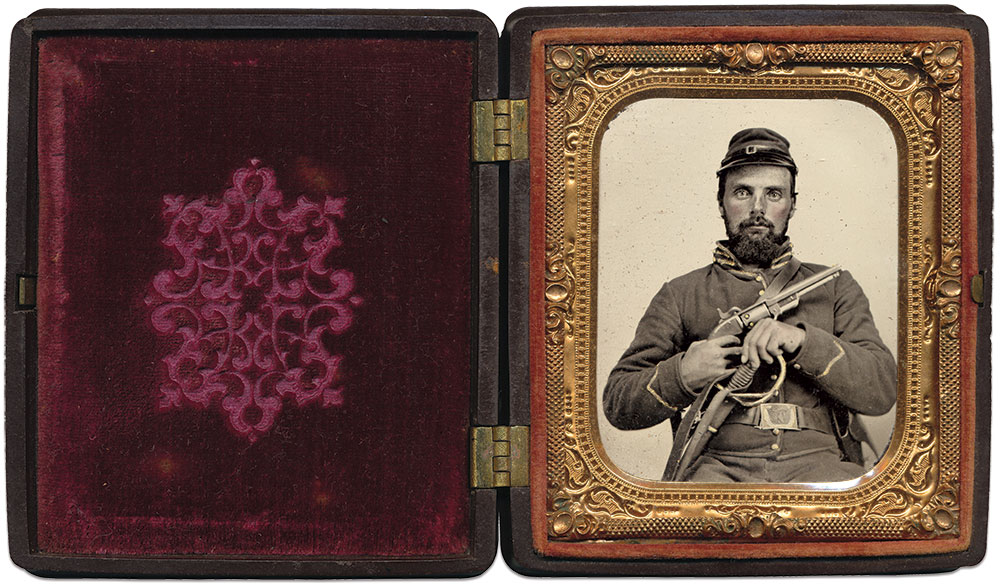
This Union cavalryman strikes a classic pose with his Savage revolver and a Model 1840 saber, also known as a “wrist-breaker” due to its heavy blade, with buff leather strap. A missing button on the right sleeve of his standard issue jacket may have been lost in camp or campaign—a gift of sorts for a future relic hunter.

Old Glory is boldly draped across the shoulder of this patriotic federal volunteer, who holds the flag in place with one hand. He wears an oversize cravat and an unusual frock coat with buttons on the collar and the three buttons of an officer on the cuffs.
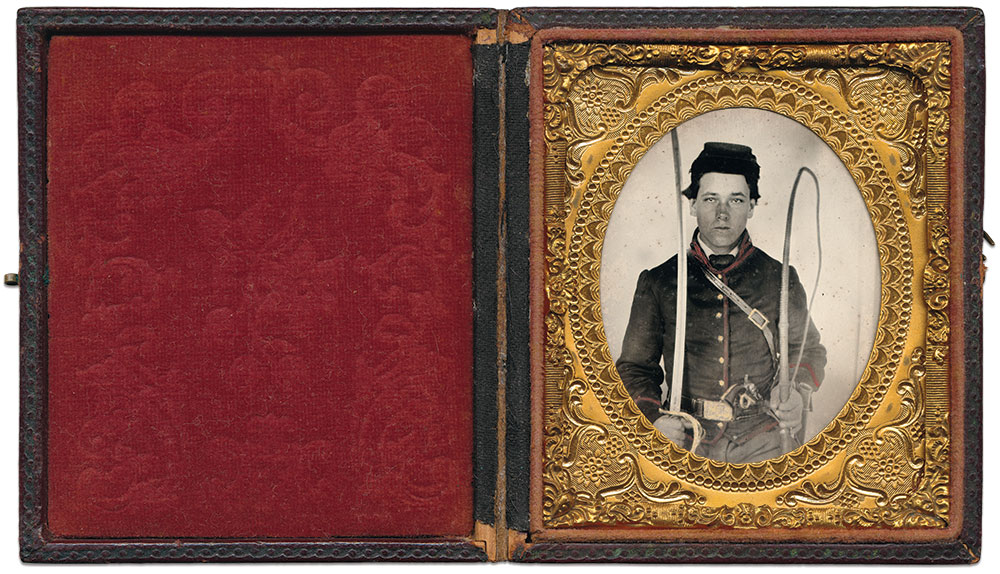
The whip and saber brandished by this Union artilleryman suggests he served in a flying battery. According to the Civil War Trust, a flying battery is defined as, “A system where several horse-drawn cannons would ride along the battle front, stop and set up the guns, fire, limber up, and ride to another position. This practice gave the impression that many guns were in use when only a few were actually being used.”
His cavalry saber is a common deviation from artillery regulations. The fluted cylinder 1862 Colt police revolver was not standard issue. The horsewhip suggests that he is a teamster with responsibility for driving a team of four horses pulling a limber and cannon or a pair of caissons.
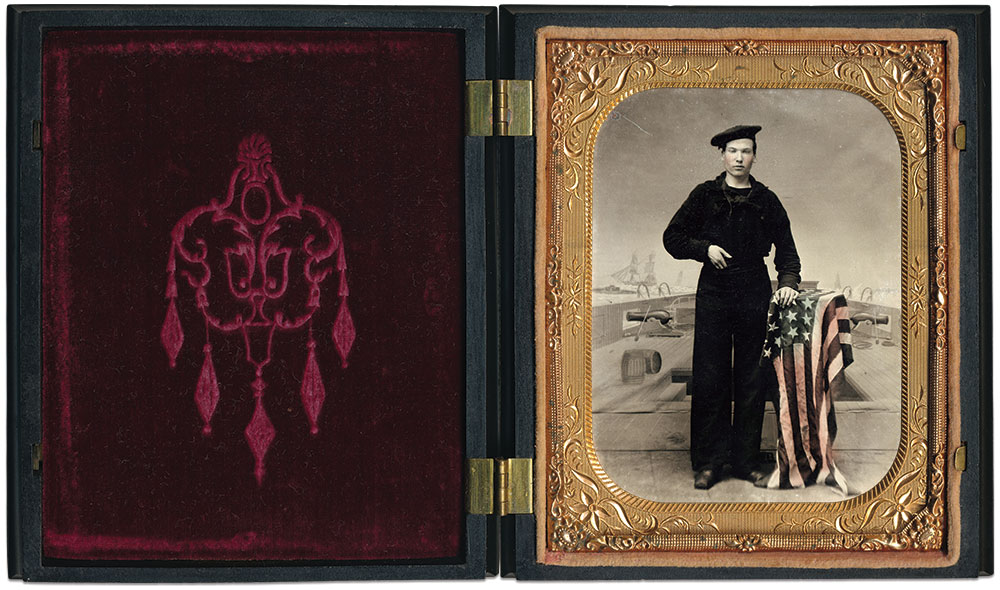
Union sailor Andrew Adams and his mates on the side-wheel gunboat Sonoma participated in operations along the South Carolina coast in early 1865 that helped clear the way for Maj. Gen. William T. Sherman’s bummers as they invaded the Carolinas. A native of Ireland, Adams had joined the navy as a landsman the previous summer and was assigned to the crew of the Sonoma at Portsmouth, N.H., in late October 1864.
Adams wears a standard blue wool winter uniform, complete with pullover and flap front bell-bottoms. A hint of embroidery visible on his cap is an old naval tradition originally intended to help Marine sharpshooters in the rigging identify the crew.
The cold-weather uniform suggests the Adams likely posed for this portrait about the time he joined the Sonoma. He stands in front of an extraordinary navy-themed painted backdrop that features the bow of a warship and several vessels, including a Monitor-class gunboat, floating in the choppy waters. It is reasonable to assume that the photographer who owned this backdrop operated near Portsmouth or another major navy yard or place of rendezvous. A meticulously tinted U.S. flag draped over a pedestal underscores Adam’s patriotism for his adopted country.
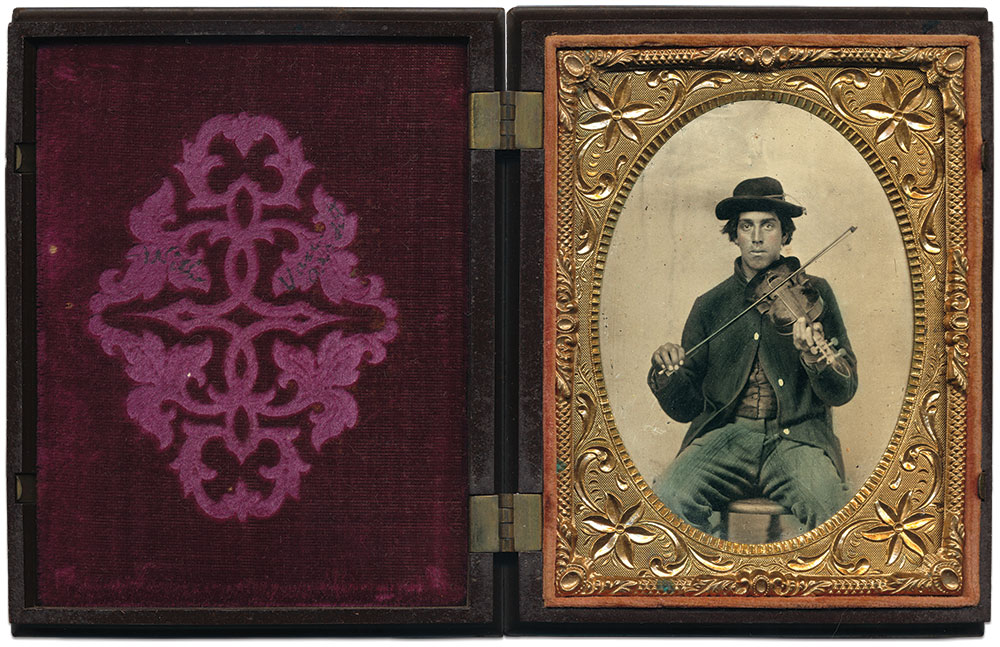
A Union violinist readies his bow in a manner that suggests he intends to play a Bach concerto rather than a knee-slapping hoe down tune. His uniform is a mesh of styles. He wears a slouch hat with officer’s hat cord, four-button sack coat, standard issue fatigue blouse and a civilian silk vest.

The unstylish narrow elbows and loose-fitting cuffs of this Confederate infantryman’s frock coat suggest that he is not from fashionable Richmond, Va., Charleston, S.C., or New Orleans. The combination of pepperbox, Bowie knife and determined expression, however, suggest that no federal soldier should trifle with him. The company letter F attached to his cap is a clue to his identity.

John Gilmer Telford gazes confidently at the camera, his face framed by a fez tilted at a rakish angle. As first lieutenant and adjutant of the 44th Ohio Infantry, 19-year-old Telford, the grandson of Brig. Gen. Joseph G. Totten, wears a double-breasted militia coat with four-button cuffs. He packs a pair of pistols and grasps a U.S. Model 1850 Foot Officer’s sword. According to a note by Telford tucked into the case, he sat for this portrait on Feb. 26, 1862, at Camp Piatt, W.Va. He added, “Nashville is ours!! Glory!!” The city had fallen to federal forces a day earlier.
Telford and his comrades spent the majority of their three-year enlistment in West Virginia and Kentucky. In January 1864, many in the regiment reformed as the 8th Ohio Cavalry. Telford however joined the U.S. Volunteers Adjutant General’s Department as a captain and served in this capacity for the remainder of the war. He continued in the regular army with the 13th Infantry and 2nd Artillery, and as an aide to several generals, including William T. Sherman and Alfred H. Terry.
Telford’s promising career was cut short in 1873 when he died of disease, which according to a newspaper report was the result of hardships in camp and campaign during the war. His wife, Elizabeth, whom he married in 1868, barely outlived him. She passed in 1874.
NOTE: Telford’s use of the abbreviation “W.Va.” is a reference to the western region of Virginia rather than the state of West Virginia, which would be admitted to the Union on June 20, 1863.

Ten troopers from the 5th Ohio Cavalry pose with their mountain howitzer. Frequent MI contributor Mike Cunningham observes, “It appears that the troopers have received field artillery training, with eight cannoneers in their approximately correct positions by the piece, and two remaining as limber drivers. The men would be numbered 1 to 7, with one man designated the gunner.” He adds that the positions are approximate, “because half of the crew should be on the far side of the piece. Men should be holding a sponge and rammer, and the limber with ammunition chest should be six yards to the rear of the pieces, with the horse holders even further to the rear. Instead, most of the cannoneers are on the near side of the piece, with their arms formally folded to remain steady while the exposure is made. These compromises are made in the interests of photography.”
Cunningham also observes that the men wear soft slouch hats instead of stiff Hardee hats, shell jackets rather than fatigue blouses and sky blue trousers. These uniform details suggest the image was made in 1862 or slightly later. During this time, the regiment was stationed in Tennessee, where it participated in the Battle of Shiloh on April 6-7, 1862, and other operations. The 5th went on to fight Confederates in other Southern states through the rest of the war, including the March to the Sea and the Carolinas Campaign.
The long shadows and thick foliage indicate that this image was made in the later afternoon of a day during the warmer months of the year.
SPREAD THE WORD: We encourage you to share this story on social media and elsewhere to educate and raise awareness. If you wish to use any image on this page for another purpose, please request permission.
LEARN MORE about Military Images, America’s only magazine dedicated to showcasing, interpreting and preserving Civil War portrait photography.
VISIT OUR STORE to subscribe, renew a subscription, and more

